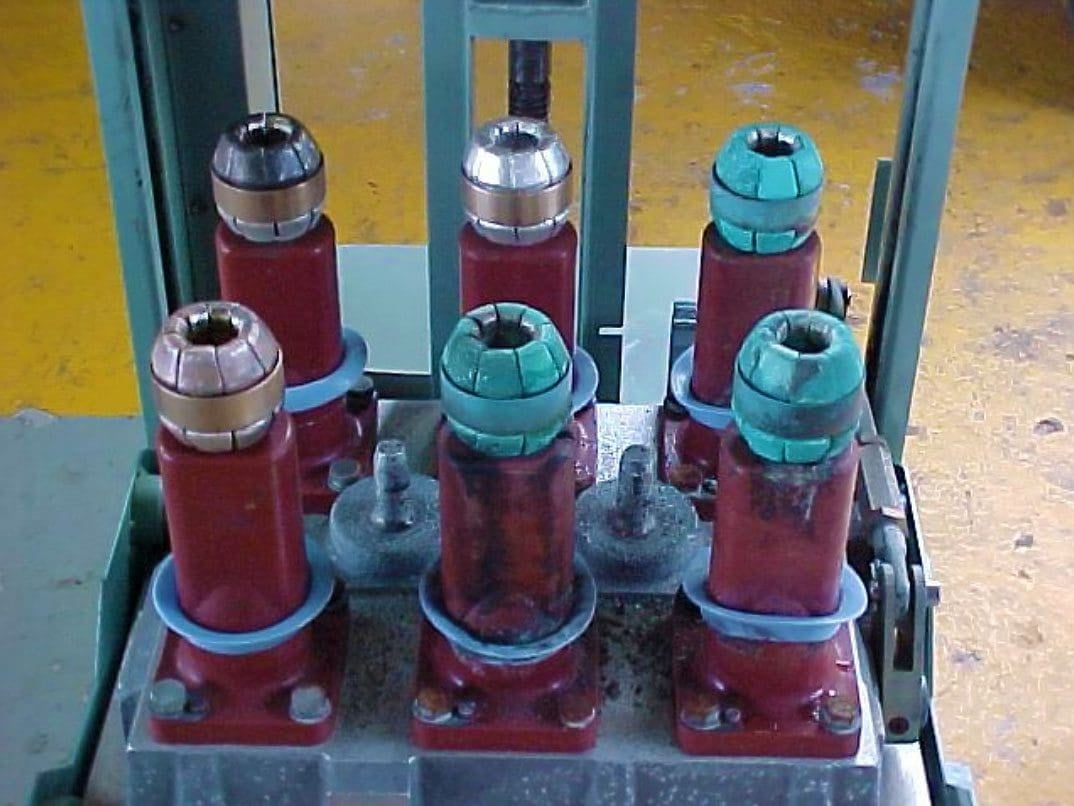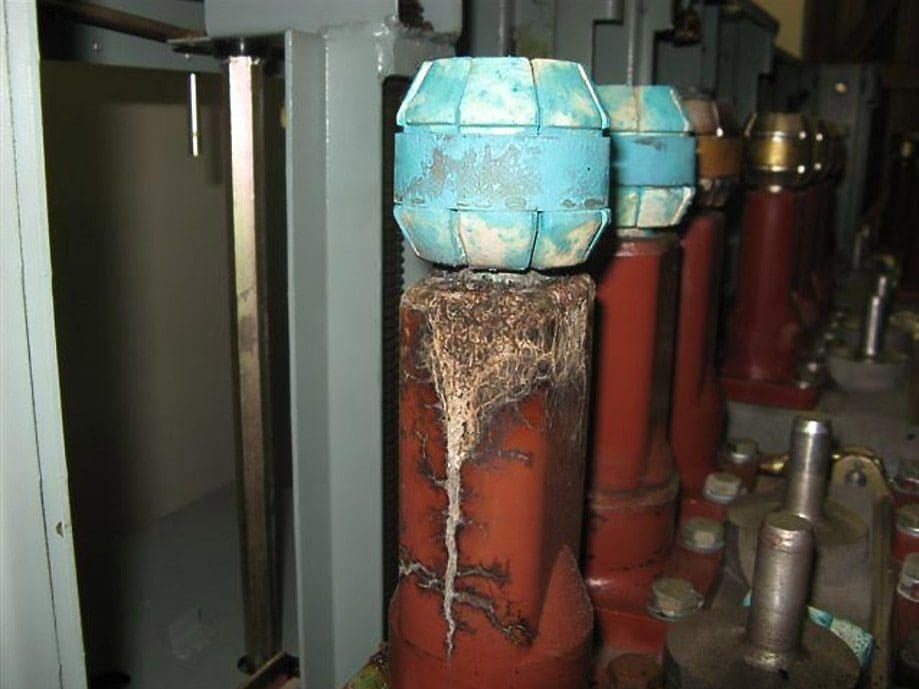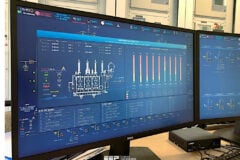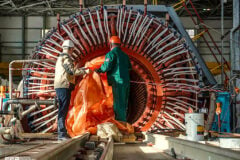The Failure & Explosive Nature
Generally, the useful life of power system components heavily depends upon the level of care given to them and their duty cycles. For example, a circuit breaker on mainly switching duty can last 40 to max. 50 years. The majority of transformers at the utilities serve about 40 years if none of the catastrophic events such as lightening happen. On the other hand, on-line tap changers in HV transformers are prone to failure.

HV bushings are accounted for as one of the most significant single causes of failure in MV/LV substations. The failure mechanisms tend to develop to a critical level at a midlife point for the surrounding assets and such mechanisms generally result in a sudden and catastrophic failure of an explosive nature, thus significantly shortening the life span of HV substations.
- CB Bushing Failures In MV Switchgear
- Case Studies of MV Switchgear Failures
- Metal-Clad Switchgear Failures
- Failure of MV Power Cables
- Low-Voltage Switchboard Failure
1. CB Bushing Failures In MV Switchgear
Violent bushing failures in MV switchgear, if they happen, may cause catastrophic damage to the surrounding buildings and adjacent plants. For example, a significant number of such catastrophic failures are presented in a report from the City of Cape Town in South Africa.
Multiple failures began occurring after the manufacturers replaced previously used Bakelite paper bushings with resin cast bushings. The replacement was related to the expansion of SF6 and vacuum technology with the supposed advantages of resin cast technology. Resin cast insulators are considered have greater suitability for mass production, superior fault toleration, resistance to scratch, and mechanical damage resistance.
To fit them in the same panel as the older oil breakers, some manufacturers would redesign existing breakers to use SF6 and resin cast technology. South African utilities used three models of SF6 MV switchgear from the same manufacturer, which are all interchangeable with previous generation oil breakers.
However, contrary to the expectations, the City of Cape Town experience showed that bakelite paper bushings outperform resin cast bushings by far.
In 2004, the substation experienced a number of the earliest known failures in the City of Cape Town. Chlorine was strongly odorated when staff entered the substation for switching operations. Upon further inspection, they discovered that the breaker had severe discharge degradation on the bushing insulation and cluster contacts. At the substations, there was also severe corrosion, tracking, and cluster degradation (Figures 1 and 2).
Figure 1 – Failed breaker with severe discharge degradation on bushing insulation and cluster contacts


Figure 2 – Another case of degradation of CB clusters and bushings


During inspection, other defects have been found, such as pores beneath the skin of the bushing resin (manufacturing defects), as well as misalignment of shutter boxes (signs of poor quality control during manufacturing).
Based on inspection results and root cause investigation, severe partial discharge activity was determined as the primary cause of failures. The probability of partial discharge activity was increased due to multiple local regions of electrical stress created within voids, pores, and bubbles in resin moldings.
However, while most of the new switchgear panels are fitted with heaters, some manufacturers specify panel heaters as optional.
Misalignment of the breaker may play a significant role in increased partial discharge activity. Because the shutter box apertures are positioned unevenly, the electrical field around the bushing is inconsistent if the breaker bushings and the corresponding orifice bushings are out of alignment. The same result could be achieved by misaligned shutter boxes.
Breakers that are not aligned properly run the risk of damaging the orifice (female) bushing and tracking. Operating these breakers might be risky.
Figure 3 – Severe corrosion degradation of circuit breaker clusters


Figure 4 – Severe corrosion degradation of circuit breaker and tracking on the bushings


Go back to the Contents Table ↑
2. Case Studies of MV Switchgear Failures
The MV switchgear failures can be attributed to inadequate design. However, inadequate maintenance procedures that fail to stop and identify mechanical and electrical issues that cause failures are more frequently to blame for failures. Increased load densities also put a great deal of strain on the infrastructure of the current, outdated MV switchgear.
Solutions frequently make an effort to balance the competing demands of upholding high availability and reliability while keeping costs down and offering the highest levels of safety.
Errors in design, defects of the components, and human mistakes, and a combination of all these, may cause severe MV switchgear failure.
2.1 Case #1: Component Defect
The following failure happened with a feeder breaker, which was taken out for performing CM tests. The breaker was racked in the “test” position and the wires for the timing test were attached to the arms of the breaker. When inserted in the “test” position, the breaker flashed over. It was discovered that the mechanical interlock’s failure was what led to flashover.
The test equipment’s metallic clamp came within arcing range of the live busbar when it was connected to the breaker, which led to the flashover.
Membership Upgrade Required
This content is not available in your premium membership plan. Please upgrade your plan in order to access this content. You can choose an annually based Basic, Pro, or Enterprise membership plan. Subscribe and enjoy studying specialized technical articles, online video courses, electrical engineering guides, and papers.
With EEP’s premium membership, you get additional essence that enhances your knowledge and experience in low- medium- and high-voltage engineering fields.
Black Friday Deal 💥 – Save 20% on Pro Plan with code BLACKFRIDAY
Copyright Notice
This technical article is protected by U.S. and international copyright laws. Reproduction and distribution of PDF version of this technical article to websites such as Linkedin, Scribd, Facebook and others without written permission of the sponsor is illegal and strictly prohibited.© EEP-Electrical Engineering Portal.
Related electrical guides & articles
Premium Membership
Edvard Csanyi
Hi, I'm an electrical engineer, programmer and founder of EEP - Electrical Engineering Portal. I worked twelve years at Schneider Electric in the position of technical support for low- and medium-voltage projects and the design of busbar trunking systems.I'm highly specialized in the design of LV/MV switchgear and low-voltage, high-power busbar trunking (<6300A) in substations, commercial buildings and industry facilities. I'm also a professional in AutoCAD programming.
Profile: Edvard Csanyi










